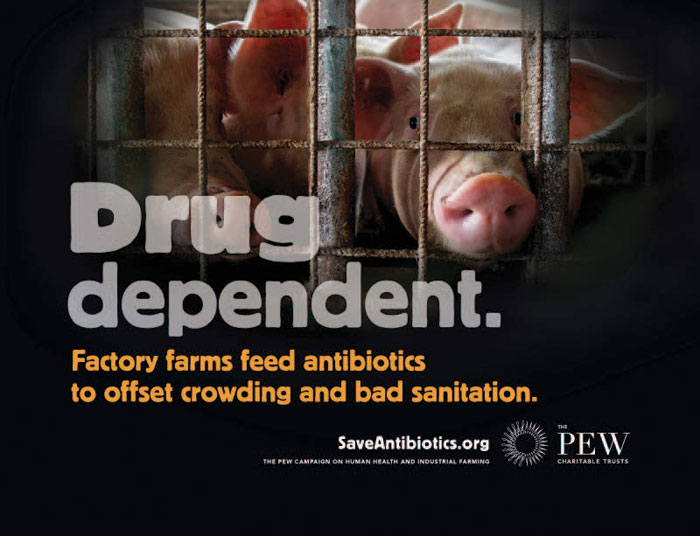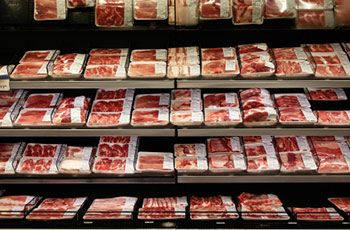Food Animal Production and Antibiotic Resistance
The Challenge
Antibiotics are one of the most important tools in modern medicine. These drugs can mean the difference between life and death when humans contract a bacterial infection—from staph to salmonella to bacterial pneumonia. But overuse and misuse of these drugs are making bacteria more quickly resistant to essential antibiotics.
Antibiotic resistance complicates medical treatment, and frequently results in longer, more serious illnesses, and even death in some instances. Resistant bacterial infections are harder to treat, and require multiple applications of antibiotics, longer hospital stays and possibly other interventions. Children, the elderly and the chronically ill are particularly vulnerable to antibiotic-resistant infections. In 1998, the Institute of Medicine estimated that antibiotic resistance generated at least $4 billion to $5 billion per year in extra costs to the U.S. health care system. More recently, researchers with the Alliance for the Prudent Use of Antibiotics and Cook County Hospital in Chicago estimated that this number has grown to $16.6 billion to $26 billion per year. For these reasons, the Centers for Disease Control and Prevention (CDC) has declared that antibiotic resistance is among its top concerns.
 The Link to Food Animal Production
The Link to Food Animal Production
In humans, antibiotic use is generally confined to treatment of illness. In contrast, antibiotics are used in food animal production not only to treat sick animals but also to prevent illness and spur growth. In fact, up to 70 percent of all antibiotics sold in the U.S. are given to healthy food animals.
The Solution
Data show that improving management of food animals (for example, cleaning facilities more thoroughly and frequently) achieves the same benefits as routine use of antibiotics in healthy animals, without undermining the integrity of the antibiotic medicines we rely on to protect public health.
That's why the FDA recommended to the U.S. Congress in 2009 that “to avoid unnecessary development of resistance under conditions of constant exposure (growth promotion/feed efficiency) to antibiotics, the use of antimicrobials should be limited to those situations where human health and animal health are protected. Purposes other than for the advancement of animal or human health should not be considered judicious use. Eliminating these uses will not compromise the safety of food.”
Working together, citizens, government, industry and public interest organizations have the tools to reduce the overuse and misuse of antibiotics:
- Individuals can practice safe and effective use of antibiotics by only taking them when and as prescribed by a doctor.
- The food animal industry can adopt cost-effective alternative hygienic strategies for preventing illness in animals and discontinue use of antibiotics in feed for growth promotion and feed efficiency.
There are alternative methods to raising food animals on industrial farms that do not risk eroding the effectiveness of antibiotics. For example:
- The USDA acknowledged in a January 2009 report that the presumed economic and production benefits of antibiotics in animal feed can be largely achieved by improved cleanliness of animal houses and improved testing for diseases.
- The WHO reported in 2000 that antibiotics should “not be used as an alternative to high-quality animal hygiene. Evidence shows that farmers who stopped relying on antimicrobials as growth promoters in livestock have experienced no economic repercussions—provided animals were given enough space, clean water, and high-grade feed.”
- The National Academy of Sciences reviewed meat consumption based on 1997 figures to determine the cost of removing the routine use of antibiotics in food animals. The results showed that on the high end of the assumptions, every person would pay $9.72 more per year for the meat they purchase.
International Leadership
Denmark is a leader in scaling back the use of antibiotics in food animal production. The Danes prohibited the administration of antibiotics in healthy food animals (cattle, chicken and pigs) for production purposes, such as growth promotion, in the late 1990s. The WHO has found that the ban on using antibiotics in healthy food animals in Denmark reduced human health risks without significantly harming animal health or farmers' incomes.
Private Sector Leadership
Increasingly, leaders in the private sector are stepping up to demonstrate that food can be produced on a large scale without use of chemicals, antibiotics and other techniques that have the potential to harm human health. Additionally, consumers are increasingly demanding clean, safe food production. That is why food producers, grocery stores and restaurant chains are increasingly marketing their products under the banners of “organic,” “natural,” and “raised without antibiotics.”
On the Farm
Small but growing numbers of farms in the U.S. are becoming certified organic, raising livestock on organic feed and without the use of hormones or antibiotics in healthy animals, while managing animal care in ways that more closely resemble natural behavior. Other farms also choose to raise their food animals in similar sustainable manners and label their meat “natural.”
At the Grocery
 Whether shopping at a farmers' market, natural food store or local grocery store, today's consumers have more places to find and purchase meats and poultry raised without the routine use of antibiotics. Download the PDF for examples.
Whether shopping at a farmers' market, natural food store or local grocery store, today's consumers have more places to find and purchase meats and poultry raised without the routine use of antibiotics. Download the PDF for examples.
In Restaurants
Demand for meat from food animals raised without the routine use of antibiotics goes beyond the grocery store. Chipotle Mexican Grill, Chop't Creative Salad Company, and Panera Bread Company are just a few leaders in the restaurant industry that have started serving meat from food animals raised without the routine use of antibiotics.
Congressional Leadership
Because of both poor regulation and oversight of drug use in industrial food animal production, consumers in the U.S. do not know what their food is treated with, or how often. Nor is there an adequate system in place to test meat for dangerous antibiotic-resistant bacteria. In order to limit the development of antibiotic-resistant bacteria in food animals and the threat it poses to people, the overuse and misuse of antibiotic drugs in poultry and livestock must be discontinued, and antibiotic use must be more carefully regulated and monitored. Congress can tackle the problem by reforming reporting and monitoring requirements for drug manufacturers and food producers and by passing legislation that would curtail the routine use of antibiotics on industrial farms.
In the 112th Congress, legislation was introduced that would address this issue. The Preservation of Antibiotics for Medical Treatment Act would withdraw the routine, non-therapeutic use of seven classes of antibiotics vitally important to human health from food animal production unless animals or herds are sick with diagnosed. Federal legislation such as this and/or regulation is needed in order to preserve the effectiveness of these life-saving drugs and to protect human health.
Our Campaign
The Pew Campaign on Human Health and Industrial Farming is working to save antibiotics by phasing out the routine use of the drugs in food animal production. We work with public health leaders, veterinarians, agricultural interests, academics and citizens' groups who share our objective of preserving the integrity of antibiotics as a means of protecting human and animal health.






